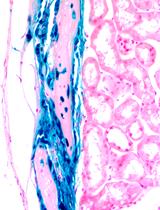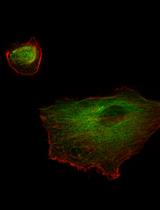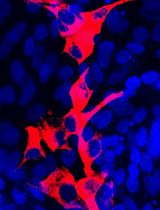- EN - English
- CN - 中文
Murine Hair Follicle Derived Stem Cell Transplantation onto the Cornea Using a Fibrin Carrier
使用纤维蛋白载体将小鼠毛囊源性干细胞移植到角膜
发布: 2018年05月20日第8卷第10期 DOI: 10.21769/BioProtoc.2849 浏览次数: 6312
评审: Vivien Jane Coulson-ThomasDongsheng JiangAnonymous reviewer(s)
Abstract
The goal of this protocol is to establish a procedure for cultivating stem cells on a fibrin carrier to allow for eventual transplantation to the eye. The ability to transfer stem cells to a patient is critical for treatment for a variety of disorders and wound repair. We took hair follicle stem cells from the vibrissae of transgenic mice expressing a dual reporter gene under the control of the Tet-on system and the keratin 12 promoter (Meyer-Blazejewska et al., 2011). A clonal growth assay was performed to enrich for stem cells. Once holoclones formed they were transferred onto a fibrin carrier and cultivated to obtain a confluent epithelial cell layer. Limbal stem cell deficient (LSCD) mice were used as the transplant recipient in order to test for successful grafting and eventual differentiation into a corneal epithelial phenotype.
Keywords: Holoclones (全克隆)Background
Stem cells are widely used as a therapeutic tool, thus a means for delivery is essential. In fact, many researchers and companies are searching for the best way to deliver cells into the human body to optimize cell survival as well as integration into the host tissue. Injection methods have been widely used in animal models but often result in poor survival and integration. Techniques utilizing biomaterials and surgical devices are currently being employed. One technique that has been utilized to deliver stem cells is fibrin carriers. Fibrin gel is a degradable biopolymer that can adhere to native tissue allowing for cell attachment, migration and proliferation (Ehrbar et al., 2005). Fibrin gels have many advantages including biocompatibility, controlled degradation (Kjaergard et al., 1994; Sidelmann et al., 2000), uniform cell distribution and high cell seeding efficiency (Swartz et al., 2005). Fibrin gels have been utilized for treating skin burns (Pellegrini et al., 1999; Ronfard et al., 2000), junctional epidermolysis bullosa (Hirsch et al., 2017) and corneal damage (Pellegrini et al., 1997; Rama et al., 2010). The method described here uses a fibrin carrier to transplant hair follicle derived stem cells onto the ocular surface of a limbal stem cell-deficient mouse. Cell engraftment and differentiation was assessed for a 5-week period via fluorescent microscopy.
Materials and Reagents
- TISSEEL [Fibrin Sealant] (Baxter, catalog number: 1501261 )
- Insulin syringe (Fisher Scientific, catalog number: 14-829-1A)
Manufacturer: BD, catalog number: 329420 . - 6-well plates (Corning, Falcon®, catalog number: 353934 )
- Pipette tips (MidSci, Avant low binding tips)
- Transfer pipet
- HFSC discs
- Ethilon 10-0 nylon sutures (Ethicon, catalog number: 9006G )
- Microscope slides (Fisher Scientific, catalog number: 12-552-3 )
- Coverglass 22 x 50 (Fisher Scientific, catalog number: 12-548-5E )
- Thrombin
- C57BL/6 mice (THE JACKSON LABORATORY, catalog number: 000664 )
- K12rtTA/rtTA/tetO-cre/ROSAmTmG transgenic mice (see Notes)
- 0.9% saline (Fisher Scientific, catalog number: 23-535435 )
- BioGlo fluorescein sodium ophthalmic strips (Hub Pharmaceuticals, NDC 17238-900-11)
- Doxycycline chow (Custom Animal Diets, catalog number: AD3008 )
- Avastin (bevacizumab, Genentech, Inc.)
- Anti-inflammatory drops–Inflanefran forte (Allergan, NDC 11980-180)
- 16% paraformaldehyde (Electron Microscopy Sciences, catalog number: 15710 )
- Sodium borohydride (Sigma-Aldrich, catalog number: 71320 )
- DAPI (Thermo Fisher Scientific, InvitrogenTM, catalog number: D3571 )
- Sodium chloride (NaCl) (Fisher Scientific, catalog number: BP358-1 )
- Calcium chloride (CaCl2) (Acros Organics, catalog number: 349610025 )
- Dulbecco’s modified Eagle medium (DMEM) without calcium and magnesium (Thermo Fisher Scientific, GibcoTM, catalog number: 21068028 )
- Ham’s F12 Nutrient Mix (Thermo Fisher Scientific, GibcoTM, catalog number: 11765047 )
- Fetal bovine serum (FBS) (Thermo Fisher Scientific, GibcoTM, catalog number: 10082147 )
- Human recombinant epidermal growth factor (Merck, catalog number: GF144 )
- L-Glutamine (Thermo Fisher Scientific, GibcoTM, catalog number: 25030081 )
- Human corneal growth supplement (Thermo Fisher Scientific, GibcoTM, catalog number: S0095 )
- Penicillin-streptomycin (10,000 U/ml) (Thermo Fisher Scientific, GibcoTM, catalog number: 15140148 )
- GibcoTM Amphotericin B (Thermo Fisher Scientific, catalog number: 15290026 )
- Sodium phosphate dibasic, anhydrous (Na2HPO4) (Sigma-Aldrich, catalog number: S7907 )
- Sodium phosphate monobasic, anhydrous (NaH2PO4) (Sigma-Aldrich, catalog number: S8282 )
- Analytical grade glycerol (Sigma-Aldrich, catalog number: G6279 )
- Mowiol 4-88 (Merck, catalog number: 475904 )
- Tris (Fisher Scientific, catalog number: BP152-1 )
- Ketamine/HCl 100 mg/ml (KetaJect; Henry Schein Animal Health, catalog number: 010177 )
- Xylazine AnaSed® 100 mg/ml (Santa Cruz Biotechnology, catalog number: sc-362949Rx )
- Fibrinogen solution (see Recipes)
- Thrombin solution (see Recipes)
- Stem cell media (see Recipes)
- 0.1 M Phosphate Buffer, pH 7.4 (see Recipes)
- Mowiol mounting medium (see Recipes)
- Ketamine/xylazine solution (see Recipes)
Equipment
- Algerbrush II Corneal rust ring remover (MicroSurgical Technology, catalog number: AM0100 )
- Inverted Fluorescence Microscope (Zeiss Observer Z1 with an apotome attachment) (ZEISS, model: AxioObserver Z1 )
- Suture Tying Forceps (Fine Science Tools, catalog number: 18025-10 )
- Microdissection scissors (Fine Science Tools, catalog number: 15000-00 )
- Epi-fluorescent stereomicroscope (ZEISS, model: Stemi SVII )
- BSL2 Laminar Flow Hood (Thermo Fisher Scientific, Thermo ScientificTM, model: 1300 Series A2 , catalog number: 1387)
- Hemocytometer (Hausser Scientific, catalog number: 3200 )
- CO2 Incubator (Thermo Fisher Scientific, Thermo ScienticTM, model: NAPCO Series 8000 WJ )
- Dissecting Scope (ZEISS, model: Stemi DV4 )
- Centrifuge (Hettich, model: Rotina 35 )
Software
- AxioVison 4.7
Procedure
文章信息
版权信息
© 2018 The Authors; exclusive licensee Bio-protocol LLC.
如何引用
Call, M., Meyer, E. A., Kao, W. W., Kruse, F. E. and Schloetzer-Schredhardt, U. (2018). Murine Hair Follicle Derived Stem Cell Transplantation onto the Cornea Using a Fibrin Carrier. Bio-protocol 8(10): e2849. DOI: 10.21769/BioProtoc.2849.
分类
干细胞 > 成体干细胞 > 上皮干细胞
干细胞 > 成体干细胞 > 细胞移植
细胞生物学 > 细胞移植 > 同种异体移植
您对这篇实验方法有问题吗?
在此处发布您的问题,我们将邀请本文作者来回答。同时,我们会将您的问题发布到Bio-protocol Exchange,以便寻求社区成员的帮助。
提问指南
+ 问题描述
写下详细的问题描述,包括所有有助于他人回答您问题的信息(例如实验过程、条件和相关图像等)。
Share
Bluesky
X
Copy link












